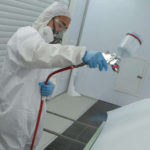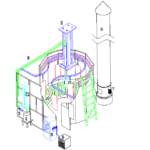What is the global explosion-proof compliance standards? Explosion-proof certification is used to determine that equipment meets the requirements of explosion-proof standards, type tests and adaptive routine tests, and issuance of relevant certificates of conformity. The certificate can be for Ex equipment or Ex components.
Equipment and protection systems used in explosive gas environments must comply with a number of regulations, standards and directives in order to enter the global trade market. It’s critical to fully understand those compliance in order to hand over the equipment to desired area. Especially in paint spraying industry, many countries require explosion-proof compliance.
The European Union’s ATEX certification adopts EN standards
The ATEX explosion-proof directive 2014/34/EU used to regulate equipment and protection systems used in potentially explosive environments is a mandatory regulation among EU member states. The hazardous locations or explosion-proof equipment intended to be installed in the EU must comply with the ATEX directive 2014/ 34/EU. The ATEX Directive ensures the free circulation of goods throughout the European Union through harmonized compliance procedures. Once the product has passed the instruction and obtained the conformity certification, it can be affixed with the CE mark and Ex mark drawings.
The IECEX certification of the International Electrotechnical Commission adopts the IEC standard
The purpose of IECEx certification is to establish an international certification system for explosion-proof products, to realize that explosion-proof products have unified standards, certificates and marks in the audit, and through the mechanism of multi-country transfer, so that products that meet the specifications can quickly enter the markets of various countries, thereby promoting international trade . Under the IECEx system, only accredited certification bodies (ExCB) and inspection laboratories (ExTL) are accepted for certification of the system.
CIS region (Russia, Belarus, Kazakhstan, Kyrgyzstan) CU-TR certification, the standard adopted is similar to the IEC Custom Union Technical Regulation Certification (CustomUnionTechnicalRegulationCertification), also known as the Customs Union Technical Regulation Certification, and its certification mark is EAC, so The English abbreviation is CU-TR certification or EAC certification. Since February 15, 2013, in order to gain access to the Customs Union (Russia, Belarus, Kazakhstan, Armenia and Kyrgyzstan) for hazardous location products, it is necessary to obtain EAC (Eurasian Conformity) Ex certification. The EACEx certificate shows compliance with the Technical Regulations of the Customs Union TPTC012/2011 “Technical Specification Directive on the Safety of Explosion-proof Equipment”.
North America (U.S. and Canada)
Explosion-proof certifications such as UL and FM in North America mainly adopt NEC local standards.
China’s explosion-proof certification adopts GB3836 standard
According to the Standardization Law of the People’s Republic of China, all explosion-proof standards are mandatory standards and must be enforced. The explosion-proof products (including imports) used in China must be certified by the designated explosion-proof inspection agency. According to the Chinese standard GB3836 series, the explosion-proof inspection and certification body issues explosion-proof qualification certificates for the examination and testing of explosion-proof performance of explosion-proof motors, explosion-proof electrical appliances, explosion-proof lamps, explosion-proof instruments, explosion-proof communication equipment, explosion-proof transportation vehicles and explosion-proof mechanical equipment. In addition to the GB3836 standard, the domestic coal safety certification also adopts China’s unique industry standards for mining products.




